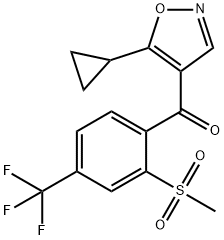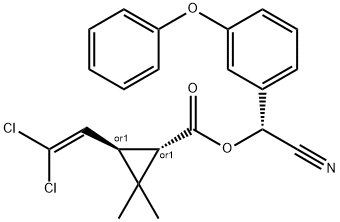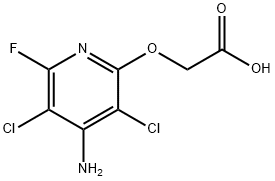IsoxaflutoleSolutioninAcetonitrile , 100 μg/mlinetonitrile, uncertainty of 3 % , 141112-29-0
Synonym(s):
5-Cyclopropyl-4-[2-(methylsulfonyl)-4-(trifluoromethyl)benzoyl]isoxazole
CAS NO.:141112-29-0
Empirical Formula: C15H12F3NO4S
Molecular Weight: 359.32
MDL number: MFCD03095707
EINECS: 277-704-1
| Pack Size | Price | Stock | Quantity |
| 1.2ml | RMB119.20 | In Stock |
|
| others | Enquire |
PRODUCT Properties
| Melting point: | 138-138.5° (Cain); mp 140° |
| Boiling point: | 575.1±50.0 °C(Predicted) |
| Density | 1.59 |
| Flash point: | >130 °C |
| storage temp. | Sealed in dry,2-8°C |
| solubility | Chloroform, DCM, Ethyl Acetate, Methanol |
| pka | -4.29±0.50(Predicted) |
| form | Solid |
| color | White |
| BRN | 8344543 |
| LogP | 2.320 |
| CAS DataBase Reference | 141112-29-0 |
| EPA Substance Registry System | Isoxaflutole (141112-29-0) |
Description and Uses
Isoxaflutole is a 4-benzoyl isoxazole molecule and is used as a pre- and early post-emergence herbicide for the control of a wide range of important broadleaf and grass weeds in maize (Zea mays), both in Europe and in North America. It is also registered for use in sugarcane in Central and South America (2–4). It causes characteristic bleaching of newly developed tissues of susceptible species followed by growth cessation and necrosis. Marketed as Balance for corn (maize) in the United States, and Merlin for corn in Europe; and in sugarcane, it mixes well with metolachlor, acetochlor, dimethenamid, and atrazine to complete the weed spectrum and to reduce the application rates of the latter compounds (2). Isoxaflutole also controls triazineresistant weeds in the field (4).
Isoxaflutole is an pesticide used to selectively control both grass and broad-leaved weeds in maize and sugar cane. Isoxaflutole is known to work by inhibiting the enzyme 4-Hydroxyphenylpyruvate dioxygenase (HPPD) which results in the disruption of pigment biosynthesis.
Safety
| Symbol(GHS) |   GHS08,GHS09 |
| Signal word | Warning |
| Hazard statements | H361d-H410 |
| Precautionary statements | P202-P273-P280-P308+P313-P391-P405 |
| Hazard Codes | Xn,N |
| Risk Statements | 50/53-63 |
| Safety Statements | 36/37-60-61 |
| RIDADR | UN3077 9/PG 3 |
| WGK Germany | 3 |
| Hazardous Substances Data | 141112-29-0(Hazardous Substances Data) |
| Toxicity | LD50 in rats, quails, mallard ducks (mg/kg): >5000, >2150, >2150 orally; in rabbits (mg/kg): >2000 dermally (Luscombe) |




![2-[4-(6-Chlorobenzo[d]oxazol-2-yloxy)phenoxy]-N-(2-fluorophenyl)-N-methylpropionamide](https://img.chemicalbook.com/CAS/GIF/256412-89-2.gif)

